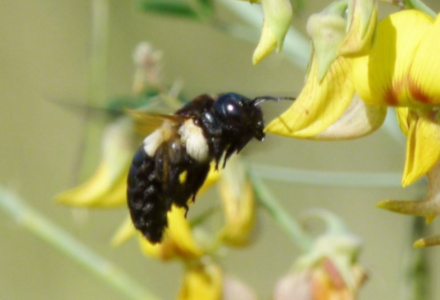
Carpenter Bee Facts
- Perhaps most notably, the term Carpenter Bee collectively refers to a very large group of highly specialized species of bees. In point of fact, it’s a huge group. That’s because more than 500 separate species list in the category known by the single common term. Furthermore, that comparatively enormous group of invertebrates is the extremely impressive genus of Xylocopa.
- Further, the collective common name derives from the fact that nearly all kinds build their nests in the same locations. These primarily consist of burrows in dead wood, bamboo, or structural timbers. The exception would be those in the subgenus Proxylocopa. These nest in the ground. Members of the related tribe Ceratinini are sometimes referred to as small carpenter bees.
- Since the name Carpenter Bee applies to so many species, the conservation statuses naturally vary. Quite unfortunately, some of them now find themselves in great danger. While this occurs for various reasons, a few of them pertain to many of the species. That’s because many of the members of the group now face the dual threats of habitat loss and climate change.
Related Articles
Cuckoo Bee Shrill Carder Bee Sweat Bee
Carpenter Bee Physical Description
Given that the term Carpenter Bee applies to such a huge number of species, physical variations quite naturally exist. Nevertheless, certain physical characteristics remain constant throughout the remarkable genus. In fact, some of the species appear so similar in appearance to each other that it can be extremely difficult for non-professionals to tell one species from the next.
For one thing, many of them can be easily mistaken for bumblebees. Most reach about 1 in (2.5 cm) in length, and display a pattern of black and yellow. For another, the principle of sexual dimorphism appears among most of the members of the genus. In this case, though, that has little to do with physical appearance. That’s because, among these bees, the females of the different varieties has the ability to sting, while the males do not.
- Kingdom: Animalia
- Phylum: Arthropoda
- Class: Insecta
- Order: Hymenoptera
- Family: Apidae
- Genus: Xylocopa
Carpenter Bee Distribution, Habitat, and Ecology
Not surprisingly, given the number of species known as Carpenter Bee, the genus appears across a large habitat range. In fact, the various members of the remarkable genus of arthropods live in Europe, Asia, and North America. In addition, the insect appears comfortable living in a relatively wide range of climates and habitats. That’s because it appears in both tropical and temperate regions.
Despite the implication of its common name, this bee does not eat wood. Actually, it chews the wood, and then discards the bits of wood or uses particles to build partitions between cells. Its tunnels function both as a nursery for breeding and storage for the pollen/nectar upon which the brood feeds. The provision masses of some kinds are among the most complex in shape of any group of bees.
Furthermore, the majority of the different types of Carpenter Bee evolved as solitary in nature. However, a few of them do live in social groups. In these, several generations of females may actually live together. These bees have numerous predators, much like most related creatures. For most of them, these consist of various birds, mantises, and even some mammals. Additionally, parasitic flies often lay eggs in the nests.
Species Sharing Its Range
Tansy Beetle Carolina Silverbell Red Panda
Check out our other articles on 7 Amazing Australian Species, Blue Footed Booby, Tierra del Fuego, Plumed midge-orchid, Numbat, Trogloraptor, Japanese Angelshark, Plumed Basilisk

